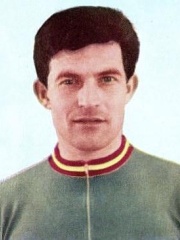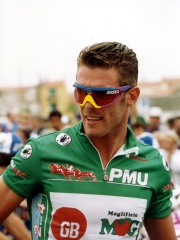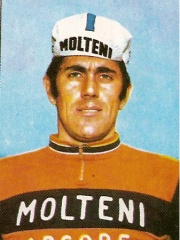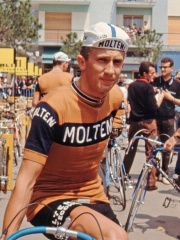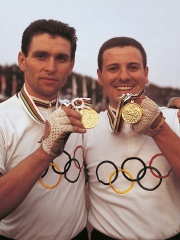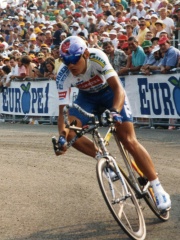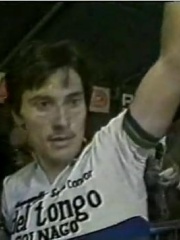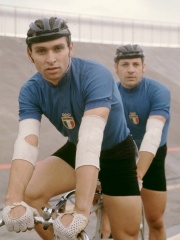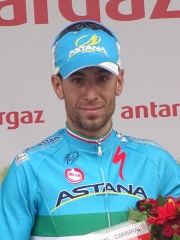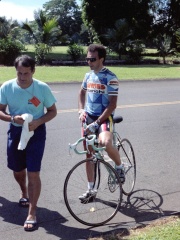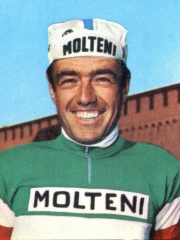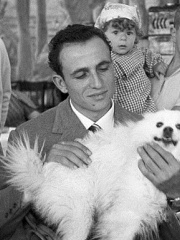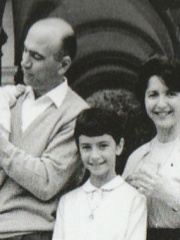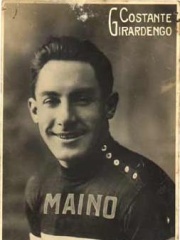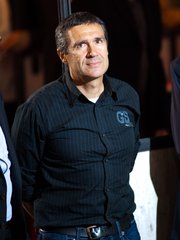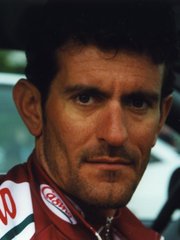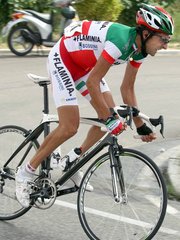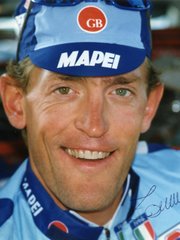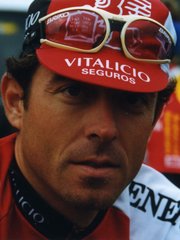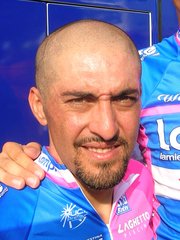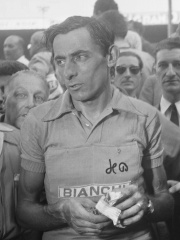
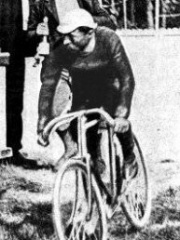
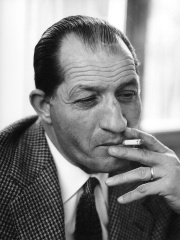
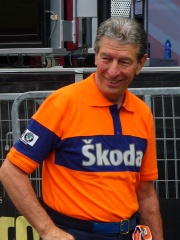
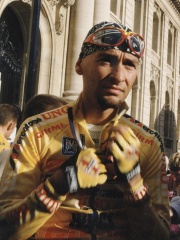
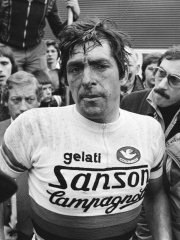
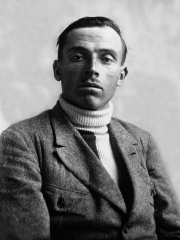
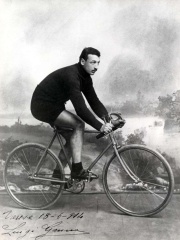
The Most Famous
CYCLISTS from Italy
Top 10
The following people are considered by Pantheon to be the top 10 most legendary Italian Cyclists of all time. This list of famous Italian Cyclists is sorted by HPI (Historical Popularity Index), a metric that aggregates information on a biography's online popularity. Visit the rankings page to view the entire list of Italian Cyclists.

1. Fausto Coppi (1919 - 1960)
With an HPI of 71.98, Fausto Coppi is the most famous Italian Cyclist. His biography has been translated into 53 different languages on wikipedia.
Angelo Fausto Coppi (Italian pronunciation: [ˈfausto ˈkɔppi]; 15 September 1919 – 2 January 1960) was an Italian cyclist, the dominant international cyclist of the years after the Second World War. His successes earned him the title Il Campionissimo ("Champion of Champions"). He was an all-round racing cyclist: he excelled in both climbing and time trialing, and was also a good sprinter. He won the Giro d'Italia five times (1940, 1947, 1949, 1952, 1953), the Tour de France twice (1949 and 1952), and the World Championship in 1953. Other notable results include winning the Giro di Lombardia five times, the Milan–San Remo three times, as well as wins at Paris–Roubaix and La Flèche Wallonne and setting the hour record (45.798 km) in 1942.

2. Maurice Garin (1871 - 1957)
With an HPI of 69.62, Maurice Garin is the 2nd most famous Italian Cyclist. His biography has been translated into 41 different languages.
Maurice-François Garin (pronounced [mɔʁis fʁɑ̃swa ɡaʁɛ̃, moʁ-]; 3 March 1871 – 19 February 1957) was an Italian-French road bicycle racer best known for winning the inaugural Tour de France in 1903, and for being stripped of his title in the second Tour in 1904 along with eight others, for cheating. He was of Italian origin but adopted French nationality on 21 December 1901.

3. Gino Bartali (1914 - 2000)
With an HPI of 68.80, Gino Bartali is the 3rd most famous Italian Cyclist. His biography has been translated into 45 different languages.
Gino Bartali, (Italian pronunciation: [ˈdʒiːno ˈbartali]; 18 July 1914 – 5 May 2000), nicknamed Gino the Pious and (in Italy) Ginettaccio, was a champion road cyclist. He was the most renowned Italian cyclist before the Second World War, having won the Giro d'Italia twice, in 1936 and 1937, and the Tour de France in 1938. After the war, he added one more victory in each event: the Giro d'Italia in 1946 and the Tour de France in 1948. His second and last Tour de France victory in 1948 gave him the largest gap between victories in the race. In September 2013, 13 years after his death, Bartali was recognised as a "Righteous Among the Nations" by Yad Vashem for his efforts to aid Jews during World War II.

4. Felice Gimondi (1942 - 2019)
With an HPI of 65.43, Felice Gimondi is the 4th most famous Italian Cyclist. His biography has been translated into 38 different languages.
Felice Gimondi (Italian pronunciation: [feˈliːtʃe dʒiˈmondi]; 29 September 1942 – 16 August 2019) was an Italian professional racing cyclist. With his 1968 victory at the Vuelta a España, only three years after becoming a professional cyclist, Gimondi, nicknamed "The Phoenix", was the second cyclist (after Jacques Anquetil) to win all three Grand Tours of road cycling: Tour de France (1965, his first year as a pro), Giro d'Italia (1967, 1969 and 1976), and Vuelta a España (1968). He is one of only seven cyclists to have done so. Gimondi also won the 1973 World Championship road race, as well as three of the five Cycling monuments, winning the Giro di Lombardia twice, and finished on the podium of a grand tour twelve times. He accomplished all of these major victories despite his career coinciding with that of Eddy Merckx.
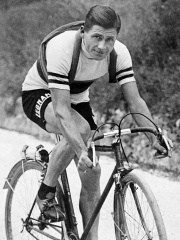
5. Alfredo Binda (1902 - 1986)
With an HPI of 64.95, Alfredo Binda is the 5th most famous Italian Cyclist. His biography has been translated into 28 different languages.
Alfredo Binda (11 August 1902 – 19 July 1986) was an Italian road cyclist of the 1920s and 1930s. He was the first to win five editions of the Giro d'Italia, and a three-time world champion. In addition he won Milan–San Remo twice, and the Tour of Lombardy four times. Later he would manage the Italian National team. Under him, Fausto Coppi, Gino Bartali and Gastone Nencini all triumphed at the Tour de France.

6. Marco Pantani (1970 - 2004)
With an HPI of 63.13, Marco Pantani is the 6th most famous Italian Cyclist. His biography has been translated into 49 different languages.
Marco Pantani (Italian: [ˈmarko panˈtaːni]; 13 January 1970 – 14 February 2004) was an Italian road racing cyclist, widely regarded as one of the greatest climbing specialists in the history of the sport by measures of his legacy, credits from other riders, and records. He recorded the fastest ever climbs up the Tour's iconic venues of Mont Ventoux (46:00) and Alpe d'Huez (36:50), and other cyclists including Lance Armstrong and Charly Gaul have hailed Pantani's climbing skills. He is the second to last rider and one of only eight to ever win the Tour de France – Giro d'Italia double, doing so in 1998. He is the sixth of seven Italians, after Ottavio Bottecchia, Gino Bartali, Fausto Coppi, Gastone Nencini and Felice Gimondi, and before Vincenzo Nibali to win the Tour de France. Pantani's cycling style was off-the-saddle, and was a relentless climbing style. His early death caused by acute cocaine poisoning in 2004 has further turned the cyclist into a popular icon. The narrative was cultivated by Pantani, who picked the nickname "Il Pirata" (English: "The Pirate") because of his shaven head and the bandana and earrings he wore. At 172 centimetres (5 feet 7+1⁄2 inches) and 58 kilograms (128 pounds), he was said to have the classic build for a mountain climber. His style has been contrasted with that of time-trialling experts such as the five-time Tour winner Miguel Induráin. Although Pantani never tested positive during his career, his career was beset by doping allegations. In the 1999 Giro d'Italia, he was expelled due to his irregular blood values. Although he was disqualified for "health reasons", it was implied that Pantani's high haematocrit was the product of EPO use. Following later accusations, Pantani went into a severe depression from which he never fully recovered, ultimately leading to his death in 2004.

7. Francesco Moser (b. 1951)
With an HPI of 62.71, Francesco Moser is the 7th most famous Italian Cyclist. His biography has been translated into 27 different languages.
Francesco Moser (Italian: [franˈtʃesko ˈmɔːzer, - moˈzɛr], German: [ˈmoːzɐ]; born 19 June 1951), nicknamed "Lo sceriffo" (The sheriff), is an Italian former professional road bicycle racer. He finished on the podium of the Giro d'Italia six times, including his win in the 1984 edition. Moser was dominant from the mid-1970s to the early 1980s. He turned professional in 1973, showing a cultured pedalling style. But his powerful build meant he was not a gifted climber. He entered one edition of the Tour de France, in 1975, where he won two stages, held the maillot jaune for six days and finished 7th overall. He also won the 1977 world road racing championship in addition to collecting silver medals in 1976 and 1978. He won six times in three of the five monuments. Three consecutive editions of Paris–Roubaix, two victories in the Giro di Lombardia and one win in Milan–San Remo. His 273 road victories puts him behind Eddy Merckx (525) and Rik Van Looy (379), but ahead of Rik Van Steenbergen (270) and Roger De Vlaeminck (255). He was also an accomplished track rider, riding up to six Six-Day races almost each winter throughout his career. He rode 35, 14 of which with René Pijnen, winning 15. A nephew, Moreno Moser, (born 25 December 1990) is an Italian professional racer, and Francesco's son Ignazio Moser enjoyed success at the junior and amateur levels before retiring at the age of 22.

8. Ottavio Bottecchia (1894 - 1927)
With an HPI of 62.21, Ottavio Bottecchia is the 8th most famous Italian Cyclist. His biography has been translated into 29 different languages.
Ottavio Bottecchia (pronounced [otˈtaːvjo botˈtekkja]; 1 August 1894 – 15 June 1927) was an Italian cyclist and the first Italian winner of the Tour de France. He was found injured and unconscious by a roadside and died a few days later; the exact circumstances of his accident remain a mystery.

9. Luigi Ganna (1883 - 1957)
With an HPI of 61.62, Luigi Ganna is the 9th most famous Italian Cyclist. His biography has been translated into 27 different languages.
Luigi Ganna (1 December 1883 – 2 October 1957) was an Italian professional road racing cyclist. He was the overall winner of the first Giro d'Italia, held in 1909, as well as the first Italian winner of the classic Milan–San Remo earlier that year. Further highlights in his career were his fifth place in the 1908 Tour de France and several podium places in Italian classic races. In 1908, he set a new Italian hour record, which he held for six years. He was born in Induno Olona, near Varese, in Lombardy. Before becoming a professional cyclist, he worked as a bricklayer, commuting up to 100 km to work by bike. In 1912, he started a bike brand named Ganna which was still around in 2012. In 1913, he started the Ganna Cycling team where he rode for the final three years of his career. His company sponsored the team until 1953 when they could no longer meet obligations and Nivea–Fuchs took over.
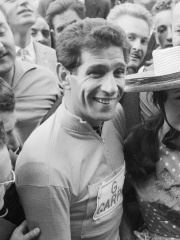
10. Gastone Nencini (1930 - 1980)
With an HPI of 60.96, Gastone Nencini is the 10th most famous Italian Cyclist. His biography has been translated into 23 different languages.
Gastone Nencini (Italian pronunciation: [ɡaˈstoːne nenˈtʃiːni]; 1 March 1930 – 1 February 1980) was an Italian road racing cyclist who won the 1960 Tour de France and the 1957 Giro d'Italia. Nicknamed Il Leone del Mugello, "The Lion of Mugello" (from his birthplace Barberino di Mugello, near Florence), Nencini was a powerful all-rounder, particularly strong in the mountains. He was an amateur painter and a chain smoker. He was a gifted descender. "The only reason to follow Nencini downhill would be if you had a death wish", said the French rider Raphaël Géminiani. It was in trying to follow Nencini down a mountain on Stage 14 of the 1960 Tour de France that Roger Rivière missed a bend, crashed over a wall and broke his spine.
People
Pantheon has 238 people classified as Italian cyclists born between 1871 and 2001. Of these 238, 189 (79.41%) of them are still alive today. The most famous living Italian cyclists include Francesco Moser, Mario Zanin, and Mario Cipollini. The most famous deceased Italian cyclists include Fausto Coppi, Maurice Garin, and Gino Bartali. As of April 2024, 44 new Italian cyclists have been added to Pantheon including Adriano Baffi, Marcello Bartalini, and Alberto Elli.
Living Italian Cyclists
Go to all RankingsFrancesco Moser
1951 - Present
HPI: 62.71
Mario Zanin
1940 - Present
HPI: 58.66
Mario Cipollini
1967 - Present
HPI: 58.07
Marino Basso
1945 - Present
HPI: 57.49
Gianni Motta
1943 - Present
HPI: 57.02
Angelo Damiano
1938 - Present
HPI: 56.45
Claudio Chiappucci
1963 - Present
HPI: 55.89
Giuseppe Saronni
1957 - Present
HPI: 55.56
Sergio Bianchetto
1939 - Present
HPI: 55.09
Vincenzo Nibali
1984 - Present
HPI: 54.91
Moreno Argentin
1960 - Present
HPI: 54.88
Franco Balmamion
1940 - Present
HPI: 54.63
Deceased Italian Cyclists
Go to all RankingsFausto Coppi
1919 - 1960
HPI: 71.98
Maurice Garin
1871 - 1957
HPI: 69.62
Gino Bartali
1914 - 2000
HPI: 68.80
Felice Gimondi
1942 - 2019
HPI: 65.43
Alfredo Binda
1902 - 1986
HPI: 64.95
Marco Pantani
1970 - 2004
HPI: 63.13
Ottavio Bottecchia
1894 - 1927
HPI: 62.21
Luigi Ganna
1883 - 1957
HPI: 61.62
Gastone Nencini
1930 - 1980
HPI: 60.96
Ercole Baldini
1933 - 2022
HPI: 60.75
Fiorenzo Magni
1920 - 2012
HPI: 60.55
Costante Girardengo
1893 - 1978
HPI: 60.37
Newly Added Italian Cyclists (2025)
Go to all RankingsAdriano Baffi
1962 - Present
HPI: 49.04
Marcello Bartalini
1962 - Present
HPI: 47.90
Alberto Elli
1964 - Present
HPI: 47.77
Rodolfo Massi
1965 - Present
HPI: 47.63
Filippo Simeoni
1971 - Present
HPI: 47.48
Claudio Vandelli
1961 - Present
HPI: 46.57
Stefano Zanini
1969 - Present
HPI: 45.39
Imelda Chiappa
1966 - Present
HPI: 44.04
Sergio Barbero
1969 - Present
HPI: 43.82
Flavio Anastasia
1969 - Present
HPI: 43.68
Andrea Ferrigato
1969 - Present
HPI: 43.20
Salvatore Commesso
1975 - Present
HPI: 42.77
Overlapping Lives
Which Cyclists were alive at the same time? This visualization shows the lifespans of the 25 most globally memorable Cyclists since 1700.

